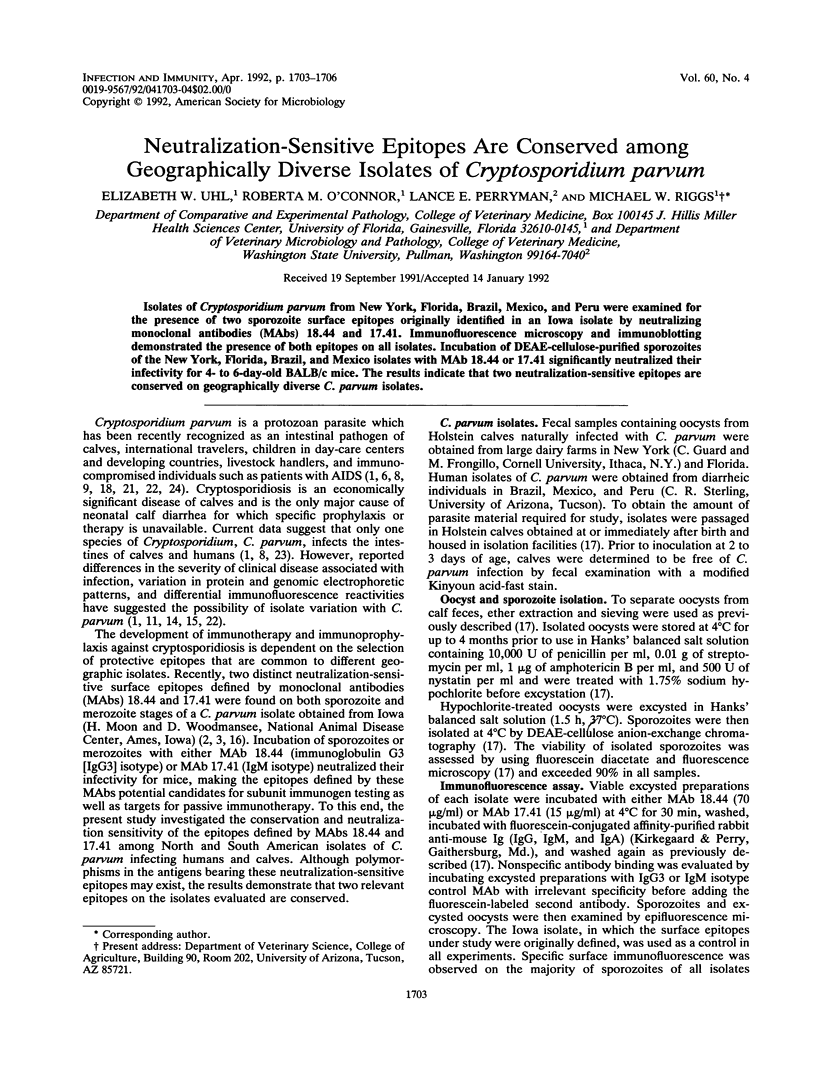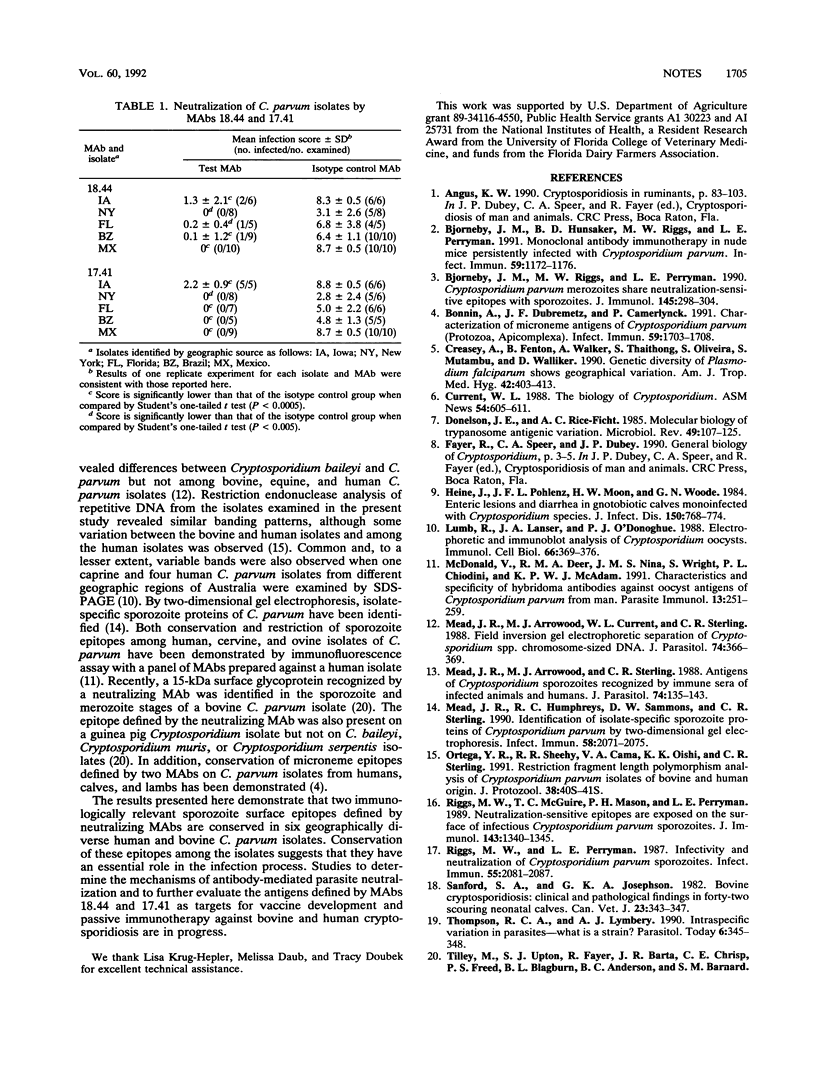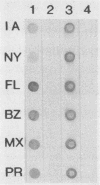Abstract
Isolates of Cryptosporidium parvum from New York, Florida, Brazil, Mexico, and Peru were examined for the presence of two sporozoite surface epitopes originally identified in an Iowa isolate by neutralizing monoclonal antibodies (MAbs) 18.44 and 17.41. Immunofluorescence microscopy and immunoblotting demonstrated the presence of both epitopes on all isolates. Incubation of DEAE-cellulose-purified sporozoites of the New York, Florida, Brazil, and Mexico isolates with MAb 18.44 or 17.41 significantly neutralized their infectivity for 4- to 6-day-old BALB/c mice. The results indicate that two neutralization-sensitive epitopes are conserved on geographically diverse C. parvum isolates.
Full text
PDF



Images in this article
Selected References
These references are in PubMed. This may not be the complete list of references from this article.
- Bjorneby J. M., Hunsaker B. D., Riggs M. W., Perryman L. E. Monoclonal antibody immunotherapy in nude mice persistently infected with Cryptosporidium parvum. Infect Immun. 1991 Mar;59(3):1172–1176. doi: 10.1128/iai.59.3.1172-1176.1991. [DOI] [PMC free article] [PubMed] [Google Scholar]
- Bjorneby J. M., Riggs M. W., Perryman L. E. Cryptosporidium parvum merozoites share neutralization-sensitive epitopes with sporozoites. J Immunol. 1990 Jul 1;145(1):298–304. [PubMed] [Google Scholar]
- Bonnin A., Dubremetz J. F., Camerlynck P. Characterization of microneme antigens of Cryptosporidium parvum (Protozoa, Apicomplexa). Infect Immun. 1991 May;59(5):1703–1708. doi: 10.1128/iai.59.5.1703-1708.1991. [DOI] [PMC free article] [PubMed] [Google Scholar]
- Creasey A., Fenton B., Walker A., Thaithong S., Oliveira S., Mutambu S., Walliker D. Genetic diversity of Plasmodium falciparum shows geographical variation. Am J Trop Med Hyg. 1990 May;42(5):403–413. doi: 10.4269/ajtmh.1990.42.403. [DOI] [PubMed] [Google Scholar]
- Donelson J. E., Rice-Ficht A. C. Molecular biology of trypanosome antigenic variation. Microbiol Rev. 1985 Jun;49(2):107–125. doi: 10.1128/mr.49.2.107-125.1985. [DOI] [PMC free article] [PubMed] [Google Scholar]
- Heine J., Pohlenz J. F., Moon H. W., Woode G. N. Enteric lesions and diarrhea in gnotobiotic calves monoinfected with Cryptosporidium species. J Infect Dis. 1984 Nov;150(5):768–775. doi: 10.1093/infdis/150.5.768. [DOI] [PMC free article] [PubMed] [Google Scholar]
- Lumb R., Lanser J. A., O'Donoghue P. J. Electrophoretic and immunoblot analysis of Cryptosporidium oocysts. Immunol Cell Biol. 1988 Oct-Dec;66(Pt 5-6):369–376. doi: 10.1038/icb.1988.48. [DOI] [PubMed] [Google Scholar]
- McDonald V., Deer R. M., Nina J. M., Wright S., Chiodini P. L., McAdam K. P. Characteristics and specificity of hybridoma antibodies against oocyst antigens of Cryptosporidium parvum from man. Parasite Immunol. 1991 May;13(3):251–259. doi: 10.1111/j.1365-3024.1991.tb00280.x. [DOI] [PubMed] [Google Scholar]
- Mead J. R., Arrowood M. J., Current W. L., Sterling C. R. Field inversion gel electrophoretic separation of Cryptosporidium spp. chromosome-sized DNA. J Parasitol. 1988 Jun;74(3):366–369. [PubMed] [Google Scholar]
- Mead J. R., Arrowood M. J., Sterling C. R. Antigens of Cryptosporidium sporozoites recognized by immune sera of infected animals and humans. J Parasitol. 1988 Feb;74(1):135–143. [PubMed] [Google Scholar]
- Mead J. R., Humphreys R. C., Sammons D. W., Sterling C. R. Identification of isolate-specific sporozoite proteins of Cryptosporidium parvum by two-dimensional gel electrophoresis. Infect Immun. 1990 Jul;58(7):2071–2075. doi: 10.1128/iai.58.7.2071-2075.1990. [DOI] [PMC free article] [PubMed] [Google Scholar]
- Ortega Y. R., Sheehy R. R., Cama V. A., Oishi K. K., Sterling C. R. Restriction fragment length polymorphism analysis of Cryptosporidium parvum isolates of bovine and human origin. J Protozool. 1991 Nov-Dec;38(6):40S–41S. [PubMed] [Google Scholar]
- Riggs M. W., McGuire T. C., Mason P. H., Perryman L. E. Neutralization-sensitive epitopes are exposed on the surface of infectious Cryptosporidium parvum sporozoites. J Immunol. 1989 Aug 15;143(4):1340–1345. [PubMed] [Google Scholar]
- Riggs M. W., Perryman L. E. Infectivity and neutralization of Cryptosporidium parvum sporozoites. Infect Immun. 1987 Sep;55(9):2081–2087. doi: 10.1128/iai.55.9.2081-2087.1987. [DOI] [PMC free article] [PubMed] [Google Scholar]
- Sanford S. E., Josephson G. K. Bovine Cryptosporidiosis: Clinical and Pathological Findings in Forty-two Scouring Neonatal Calves. Can Vet J. 1982 Dec;23(12):343–347. [PMC free article] [PubMed] [Google Scholar]
- Thompson R. C., Lymbery A. J. Intraspecific variation in parasites- what is a strain? Parasitol Today. 1990 Nov;6(11):345–348. doi: 10.1016/0169-4758(90)90410-6. [DOI] [PubMed] [Google Scholar]
- Tzipori S. Cryptosporidiosis in perspective. Adv Parasitol. 1988;27:63–129. doi: 10.1016/S0065-308X(08)60353-X. [DOI] [PMC free article] [PubMed] [Google Scholar]
- Upton S. J., Current W. L. The species of Cryptosporidium (Apicomplexa: Cryptosporidiidae) infecting mammals. J Parasitol. 1985 Oct;71(5):625–629. [PubMed] [Google Scholar]
- Wolfson J. S., Richter J. M., Waldron M. A., Weber D. J., McCarthy D. M., Hopkins C. C. Cryptosporidiosis in immunocompetent patients. N Engl J Med. 1985 May 16;312(20):1278–1282. doi: 10.1056/NEJM198505163122002. [DOI] [PubMed] [Google Scholar]



